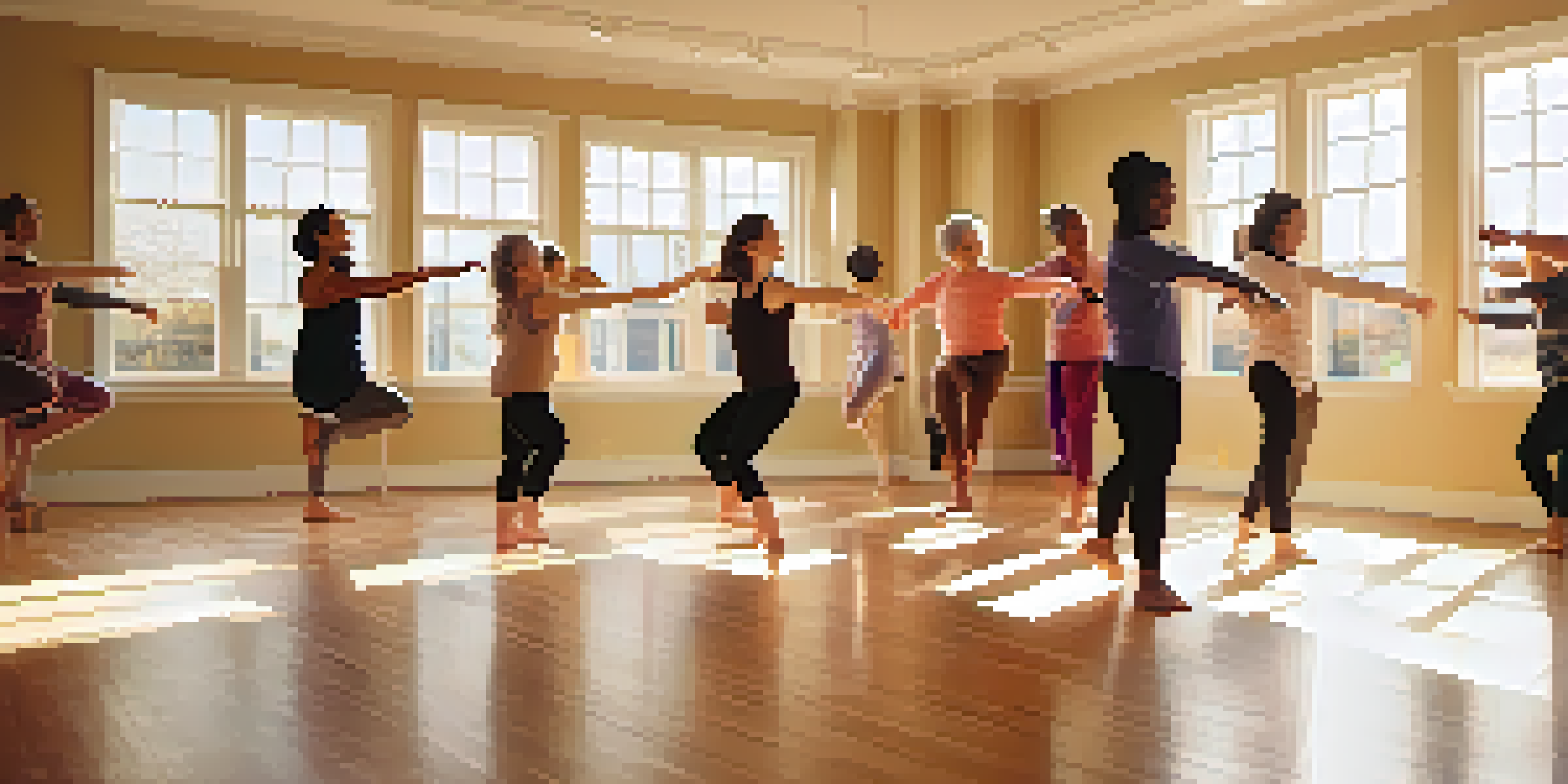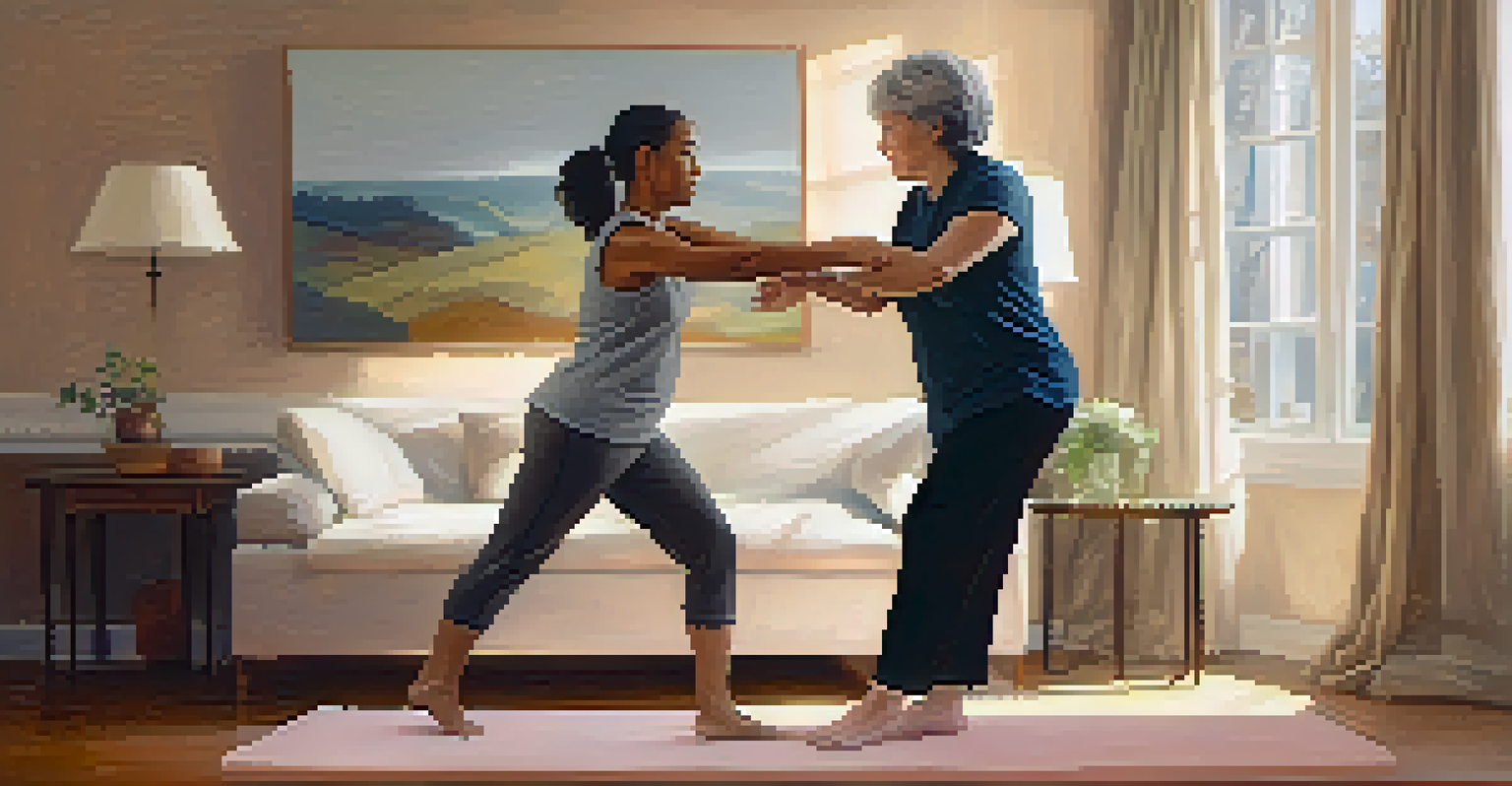Using Dance Therapy to Boost Emotional Awareness and Skills

Understanding Dance Therapy and Its Purpose
Dance therapy combines movement and creative expression to foster emotional healing. It taps into the body’s natural rhythm, allowing individuals to express feelings that words sometimes cannot capture. By engaging in dance, participants can explore their emotions in a safe, supportive environment.
Dance is the hidden language of the soul.
This therapeutic approach is beneficial for people of all ages, from children to seniors, providing a universal language of movement. Unlike traditional talk therapy, dance therapy emphasizes non-verbal communication, making it particularly useful for those who find it challenging to articulate their feelings.
Ultimately, the goal of dance therapy is to enhance emotional awareness, improve interpersonal skills, and promote overall well-being. It encourages individuals to connect with their bodies, leading to greater self-awareness and a deeper understanding of their emotional landscape.
The Connection Between Movement and Emotion
Movement is inherently tied to our emotional state, and dance therapy leverages this connection. When we move, our bodies release endorphins, which can elevate our mood and help alleviate stress. This physical response creates a powerful feedback loop where emotional expression can lead to emotional release.

Imagine a time when you felt overwhelmed—perhaps a dance party or a solo dance session helped lift your spirits. This is the essence of dance therapy; it provides a structured way to channel emotions through movement, leading to increased emotional awareness.
Dance Therapy Fosters Emotional Healing
Dance therapy uses movement to help individuals express and process emotions that may be difficult to articulate verbally.
By understanding how our bodies react to different movements, we can better recognize and process our emotions. Dance therapy not only allows for physical expression but also helps individuals identify feelings they may not have been aware of.
Building Emotional Awareness Through Dance
Emotional awareness is the ability to recognize and understand our own feelings. In dance therapy, participants learn to identify emotions by observing their physical responses during movement. For example, someone might notice tightness in their chest when feeling anxious, prompting a deeper exploration of that emotion.
Movement is a medicine for creating change in a person's physical, emotional, and mental states.
Through guided movement exercises, individuals can experiment with different ways of expressing feelings—whether through slow, flowing movements or fast, energetic ones. This experimentation fosters a deeper connection to their emotional states and helps them articulate these feelings more clearly.
As participants build their emotional vocabulary, they become more adept at recognizing emotions in themselves and others. This newfound awareness not only enhances personal insight but also improves communication and empathy in relationships.
Enhancing Social Skills with Dance Therapy
Dance therapy is not only about individual expression; it also fosters social skills in a group setting. When participants dance together, they learn to read body language, respond to peers, and collaborate on movements. This social interaction builds trust and strengthens connections among group members.
Consider a group dance session where individuals must synchronize their movements. This activity encourages teamwork, communication, and active listening, all of which are essential social skills. Participants practice expressing and interpreting emotions in a safe and supportive atmosphere.
Movement Enhances Emotional Awareness
Participants in dance therapy learn to recognize and understand their emotions through physical responses during movement.
As social skills improve, individuals often find it easier to navigate relationships outside of the therapy setting. The skills learned in dance therapy can transfer to everyday interactions, helping individuals to connect more meaningfully with others.
Coping with Trauma Through Movement
For many, trauma can manifest physically, leading to tension and emotional blockages. Dance therapy offers a unique avenue for processing these traumatic experiences. Through movement, participants can release pent-up emotions tied to trauma, allowing for healing and recovery.
In a therapeutic setting, individuals may be guided to express specific emotions related to their trauma through dance. This can be both cathartic and empowering, helping them reclaim ownership of their bodies and their stories. It allows for a non-verbal exploration of experiences that may be too painful to discuss.
As participants embrace movement as a form of expression, they often find a sense of liberation. Dance therapy can serve as a bridge, leading individuals from a place of pain to one of healing and hope.
The Role of the Dance Therapist
A dance therapist is trained to create a safe environment where individuals can explore their emotions through movement. They guide participants in various exercises tailored to their unique emotional needs and therapeutic goals. This guidance is crucial for ensuring that individuals feel secure while expressing themselves.
Additionally, dance therapists help participants set intentions for their sessions, allowing for focused exploration of specific emotions or experiences. They facilitate discussions post-session, encouraging participants to reflect on their movements and emotional discoveries.
Dance Builds Social Skills and Trust
Group dance therapy sessions promote social interaction, teamwork, and communication, enhancing relationships outside of therapy.
By building a rapport with participants, dance therapists can foster a sense of trust that is essential for emotional growth. Their expertise not only enhances the therapeutic experience but also supports individuals in developing a deeper understanding of themselves.
Integrating Dance Therapy into Daily Life
While dance therapy is often conducted in structured sessions, its principles can be integrated into daily life. Simple practices, like taking a few moments to dance freely at home, can enhance emotional awareness and provide a healthy outlet for stress. It encourages individuals to stay in tune with their feelings throughout the day.
Consider incorporating short dance breaks into your daily routine. These moments of movement can serve as a reset, helping you to reconnect with your emotions and alleviate tension. You don’t need to be a trained dancer; the focus is on expression rather than perfection.

By bringing dance into everyday life, individuals can maintain the benefits of dance therapy long after the sessions end. This ongoing practice can lead to a more profound emotional awareness and a healthier relationship with one’s feelings.